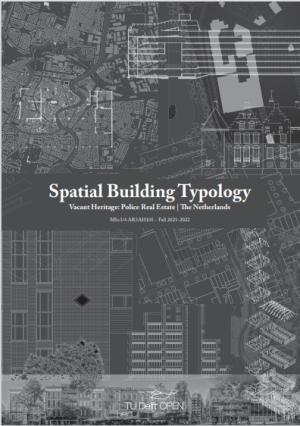Spatial Building Typology (Volume 2) Vacant Heritage: Police Real Estate | The Netherlands
Keywords:
building typology, police real estate, vacant heritage, heritage buildings, spatial developmentsSynopsis
The Dutch Police is one of the largest owners of public real estate in the Netherlands. From police station to forensic laboratory, from listed buildings in the centre of The Hague to large-scale facilities next to the motorway in Driebergen: the task of accommodating the Police is as diverse as it is challenging. Themes such as innovation and sustainability, health and safety, as well as identity, flexibility and affordability are all of relevance for the Police's accommodation strategy. Efforts are being made to strike a new balance between the physical, mobile and digital workplace.
Since the formation of the National Police, there has been an enormous challenge to accommodate the organization. In realizing this task, the police has the ambition to raise the quality of police buildings as well as the experience users have in the buildings. At the same time, the police is at the heart of an ever changing society: The accommodation needs to meet the requirements posed by several developments such as the energy transition, climate change and digitization. How do these developments influence the task of future-proofing (cultural) heritage? Which role can our heritage buildings play in these transitions?
The key lies in our present actions coupled with the lessons of the past. Different approaches on Built Heritage will open our eyes and help with today's issues. To see what is valuable. Will the decisions made in the past be our strength or pitfall? How will objects developed in the past, exposed to today's spatial developments, help us? Through the power of imagination, the Studio Vacant
heritage from Heritage and Architecture proudly reveals many possibilities.
Downloads
References
Aben, R., & Wit, S., (1999). The Enclosed Garden. 010 Publishers.
Arcadis. (2018, September). Puntensysteem voor groen- en natuurinclusief bouwen.
Azizi M. & Torabi, Z. (2015). The Role of Structure in Creating Architectural Space. Current World Environment. https://doi.org/10.12944/CWE.10.Special-Issue1.18
Bacon, E.N. (1974). Design of Cities. Harmondsworth: Penguin Books.
Bak, R. (2021). Kantoren in cijfers 2021. NVM Business.
Bloszies, C. (2012). Old Buildings, New Design. Princeton Architectural Press.
Boer, M. D. (2012). Binnen in de Stad; ontwerp en gebruik van publieke interieurs. Trancity.
Brand, S. (1995). How Buildings Learn. Van Haren Publishing.Gelders Archief: Haen (II), 1551 Topografisch-historische Atlas Gelderland, 1671 Huis 't Velde, 1726 A. de - (Abraham), Public Domain Mark 1.0 licentie.
Charleson, A. (2005). Structure as Architecture: A Source Book for Architects and Structural Engineers. Architectural Press.
Coenen, J. (2006). Art of Blending. Vssd & TU Delft R-Mit
Ebbert T., (2010). Refurbishment strategies for the technical improvement of office façades. RWTH Aachen University of Technology.
Eisenman, P. (2003). Giuseppe Terragni Transformations Decompositions Critiques. New York: The Monacelli Press.
Eisenmann, P. (2008). Ten Canonical Buildings 1950-2000. New York: Rizzoli.
Fonatti, F. (1982). Elementare Gestaltprinzipien in der Architektur. Vienna: Akademie der Bildende Künste.
Fortier, B. (1989). La Metropole Imaginaire. Un Atlas de Paris. Brussels: Pierre Mardaga
Gaventa, S., (2006). New Public Spaces. Octopus Publishing Group.
Gehl, J. (2011). Life Between Buildings. Island Press.
Gehl, J., Kaefer, L.J., & Reigstad, S. (2006). Close encounters with buildings. Urban design international, 11(1), 29-47. https://doi.org/10.1057/palgrave.udi.9000162
Gemeente Amsterdam. (2018). Natuurinclusief bouwen en ontwerpen: in twintig ideeën. Retrieved 27-09-2021, from https://www.amsterdam.nl/wonen-leefomgeving/duurzaam-amsterdam/duurzaam-ontwikkelen/amsterdams-beleid-betrekking/natuurinclusief-bouwen/
Global Footprint Network. (2021). Earth Overshoot Day. Overshootday. Retrieved 26-10-2021, from http://www.overshootday.org/
Graff, Ph. (2000). L'Exception Urbane. Nice: de la Renaissance au Consiglio d'Ornato. Marseille: Editions Paranthèse.
Güney, Y.I. (2007). Type and Typology in architectural discourse. In: BAÜ FBE Dergisi, Temmuz 2007, 3-18.
Habraken, N. J. (2000). The Structure of the Ordinary. MIT Press.
Haraguchi, H. (1988). A Comparative Analysis of 20th-Century Houses. New York: Rizzoli.
Harenberg, J. (1987). Kastelen rond Zutphen I. De Walburg Pers.
Helling, K. (2020, March). Ruimtelijke Koers: Onderzoeksresultaten werkgroep natuur, landschap en recreatie. Retrieved at 20-09-2021, from https://www.houten.nl/fileadmin/user_upload/Burgers/Wonen_en_leefomgeving/Ruimtelijke_koers/20200929/1.4_-_5._Natuur__landschap_en_recreatie.pdf
Hermans, D. R., Kolen, J. D. R., & Renes, H. (2015). Landscape Biographies: Geographical, Historical and Archaeological Perspectives on the Production and Transmission of Landscapes. Amsterdam University Press. https://doi.org/10.1515/9789048517800
IVN Natuureducatie. (n.d.). Wat is Natuurinclusief bouwen eigenlijk? Retrieved 27-09-2021, from https://www.ivn.nl/natuurinclusief-bouwen/wat-is-natuurin-clusief-bouwen-eigenlijk?
Jallon, B., & Napolitano, U. (2017). Paris Haussmann. Paris: Park Books.
Janssen, J., Luiten, E., Renes, H., & Stegmeijer, E. (2017). Heritage as sector, factor and vector: conceptualizing the shifting relationship between heritage management and spatial planning. European Planning Studies, 25(9), 1654-1672. https://doi.org/10.1080/09654313.2017.1329410
Komossa, S., Marzot, N., & Floris, J. (2011). Tekenboek Stadsgebouwen. Functie-stapelingen, publieke binnenvelden, in één blok. Rotterdam: AIR.
Kuipers, M. C., & De Jonge, W. (2017). Designing from heritage: Strategies for conservation and conversion. TU Delft-Heritage & Architecture.
Leupen, B. (2006). Frame and generic space. Rotterdam: 010 Publishers.
Lewis, P., & Tsurumaki, D., & Lewis, J. (2016). Manual of Section. New York: Princeton Architectural press.
Lewis, P., & Tsurumaki, D., & Lewis, J. (2016). Manual of Section. Princeton Architectural Press.
Maas, W., Ravon, A., Why Factory, Salij, T. H., Molenda, A., Arpa, J., & Van Waart, A. (2018). Porocity. Macmillan Publishers.
Madrazo, L. (1995). The Concept of Type in Architecture. Zürich: PhD Thesis 11115 ETH.
Meurs, P. (2021). Niets is zo duurzaam als een monument. Nationaal Restauratie Platform Nederland
Molema, J. ea (1982). J. Duiker bouwkundig ingenieur. Rotterdam: Stichting Bouw.
Molema, J.ea (1979). Gaudí rationalist met perfecte materiaalbeheersing. Delft: DUP.
Moneo, R. (1978). On Typology. In: Oppositions, MIT press 13 (1978) 22-45.
Poot, T., van Acker, M., & de Vos, E. (2016). The Public Interior: The meeting place for the urban and the interior. University of Antwerp. https://doi.org/10.37113/ideaj.vi0.52
Prudon, T.H.M. (2008). Preservation of modern architecture. Wiley.
Radford, A. (2014). The Elements of Modern Architecture. London: Thames and Hudson.
Remøy, H. (2010). Out of Office: A Study on the Cause of Office Vacancy and Transformation as a Means to Cope and Prevent. IOS Press.
Schneider, F. (1994). Floor Plan Atlas. Basel: Birkhaüser.
Straatsma, P. (2018, June 2). Mijn streek. Dagblad van het Noorden, 36-37.
Tarrafa Pereira da Silva, A. M., & Pereira Roders, A. R. (2012). Cultural heritage management and heritage (impact) assessments. In Proceedings of the Joint CIB W070, W092 & TG72 International Conference on Facilities Management, Procurement Systems and Public Private Partnership, 23-25 January 2012, Cape Town
The World Bank. (2020). Urban Development. Retrieved 22-11-2021, from https://www.worldbank.org/en/topic/urbandevelopment/overview
Van den Dobbelsteen, A. (2008). 655: Towards closed cycles - New strategy steps inspired by the Cradle to Cradle approach. Conference on Passive and Low Energy Architecture, Dublin, PLEA 2008 - 25th of October.
Van Duin, L., & Claessens, F. (2008). OverHolland. Vol. 7. Architectural studies for the Dutch city. Nijmegen: Vantilt.
Vogelzang, F. (2016). Nieuwe functies voor kastelen en buitenplaatsen. Een eeuw herbestemming. NKS
Wageningen University & Research. (n.d.). Biodiversiteit. Retrieved 20-09-2021, from https://www.wur.nl/nl/show-longread/Biodiversiteit-longread.htm
Witteveen+Bos. (2012a). Economische betekenis van historische buitenplaatsen en landgoederen in de provincies Utrecht, Overijssel en Gelderland. Vereniging Particuliere Historische Buitenplaatsen.
Witteveen+Bos. (2012b). Historische buitenplaatsen en landgoederen: In stand houden loont! Wageningen University & Research
Zijlstra, H. & L. Meijers & W. Quist & J. Dos Santos Gonçalves (2021-2). Studio Tekst. HA Vacant Heritage Politie Bouwmeester. Fall 2021 - 2021.
Zijlstra, H. (2009). Analysing Buildings from Context to Detail in time: ABCD (in time) research method. Amsterdam: IOS Press.
Zijlstra, H., et al. (2021-1). Spatial Building Typology - Vacant Heritage: Department Stores | V&D's. Delft: BK-BOOKS https://books.bk.tudelft.nl/press/catalog/book/790





